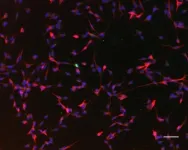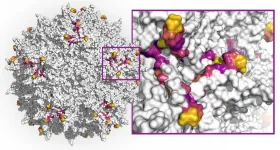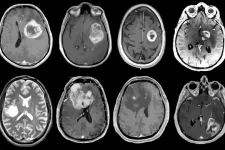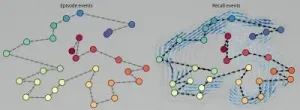INFORMATION:
The paper, published in the journal Current Biology, is entitled: "Provision of high meat content food and object play reduce predation of wild animals by domestic cats Felis catus."
Play and meaty food reduce hunting by cats
2021-02-11
(Press-News.org) Domestic cats hunt wildlife less if owners play with them daily and feed them a meat-rich food, new research shows.
Hunting by cats is a conservation and welfare concern, but methods to reduce this are controversial and often rely on restricting cat behaviour in ways many owners find unacceptable.
The new study - by the University of Exeter - found that introducing a premium commercial food where proteins came from meat reduced the number of prey animals cats brought home by 36%, and also that five to ten minutes of daily play with an owner resulted in a 25% reduction.
"Previous research in this area has focussed on inhibiting cats' ability to hunt, either by keeping them indoors or fitting them with collars, devices and deterrents," said Professor Robbie McDonald, of Exeter's Environment and Sustainability Institute.
"While keeping cats indoors is the only sure-fire way to prevent hunting, some owners are worried about the welfare implications of restricting their cat's outdoor access.
"Our study shows that - using entirely non-invasive, non-restrictive methods - owners can change what the cats themselves want to do.
"By playing with cats and changing their diets, owners can reduce their impact on wildlife without restricting their freedom."
Play in the study involved owners simulating hunting by moving a feather toy on a string and wand so cats could stalk, chase and pounce. Owners also gave cats a toy mouse to play with after each "hunt", mimicking a real kill.
It is not clear what elements of the meaty food led to the reduction in hunting.
"Some cat foods contain protein from plant sources such as soy, and it is possible that despite forming a 'complete diet' these foods leave some cats deficient in one or more micronutrients -prompting them to hunt," said Martina Cecchetti, the PhD student who conducted the experiments.
"However, meat production raises clear climate and environmental issues, so one of our next steps is to find out whether specific micronutrients could be added to cat foods to reduce hunting.
"We also plan to investigate whether different kinds of play have different effects, and whether combining strategies can reduce hunting even further."
The study - based on a 12-week trial of 355 cats in 219 households in south-west England - also examined the effect of existing devices used to limit hunting by cats.
Colourful "Birdsbesafe" collar covers reduced numbers of birds captured and brought home by 42%, but had no effect on hunting of mammals.
Cat bells had no discernible overall effect - although the researchers say the impact on individual cats varied widely, suggesting some cats learn to hunt successfully despite wearing a bell.
Lisa George, from Helston in Cornwall, who looks after Minnie, a three-year-old tabby cat who took part in the trial, said: "Minnie loves to hunt. More often than not, she will bring her prey home and let it go in the house. We've had birds in the bedroom, rats in the waste paper bin (which took us three days to catch), rabbits in the utility room.
"On changing Minnie's food (previously supermarket own-brand), to Lily's Kitchen, I found she hardly hunted at all. This continued the whole time she was on this food. I can honestly say I couldn't believe the difference as regards her hunting behaviour."
George Bradley, from project sponsors SongBird Survival, said: "This latest study we have funded is excellent news for birds.
"The data show that cat owners (like me) can make a few small and easy steps to really improve the health and happiness of our pets as well as make a really big difference for all our wildlife, especially our beloved songbirds.
"Making these easy-to-implement changes will be a win-win for birds, cats and cat owners."
Dr Sarah Ellis, Head of Cat Advocacy at iCatCare, which is part of the advisory group for this research project, said: "We are really encouraged by the findings of this study.
"While many cat owners are wildlife lovers and find the killing and injuring of wild animals by their cats upsetting, many owners also feel that keeping their cats indoors or restricting their outdoor access would impact negatively on their cats' quality of life.
"At iCatCare, we are particularly excited about the positive effects of play - this is an activity that owners can easily introduce at no or little cost, takes little time and is very cat-friendly.
"The mental and physical stimulation of predatory-like play are likely to help keep a cat in tip top condition and provide an appropriate behavioural outlet for its predatory behaviours."
Dr Adam Grogan, Head of Wildlife at the RSPCA, welcomed the results of the study.
"The RSPCA cares for both cats and wild animals and we want to provide advice to cat owners that will benefit both cat and wild animal welfare," he said.
"This project provides us with alternatives for cat owners that are simple and effective and so easy to adopt."
ELSE PRESS RELEASES FROM THIS DATE:
Artificial intelligence generates new diversity of AAV capsids for broader gene therapy
2021-02-11
Cambridge, MA - February 11, 2020 - Dyno Therapeutics, a biotech company applying artificial intelligence (AI) to gene therapy, today announced a publication in Nature Biotechnology that demonstrates the use of artificial intelligence to generate an unprecedented diversity of adeno-associated virus (AAV) capsids towards identifying functional variants capable of evading the immune system, a factor that is critical to enabling all patients to benefit from gene therapies. The research was conducted in collaboration with Google Research, Harvard's Wyss Institute for Biologically Inspired Engineering and the Harvard Medical School laboratory of George M. Church, Ph.D., a Dyno scientific co-founder. The publication is entitled "Deep diversification ...
Compounds from apples may boost brain function
2021-02-11
Natural compounds found in apples and other fruits may help stimulate the production of new brain cells, which may have implications for learning and memory, according to a END ...
Machine-learning how to create better AAV gene delivery vehicles
2021-02-11
(Boston) -- Adeno-associated viruses (AAVs) have become promising vehicles for delivering gene therapies to defective tissues in the human body because they are non-pathogenic and can transfer therapeutic DNA into target cells. However, while the first gene therapy products approved by the Federal Drug Administration (FDA) use AAV vectors and others are likely to follow, AAV vectors still have not reached their full potential to meet gene therapeutic challenges.
First, currently used AAV capsids - the spherical protein structures enveloping the virus' single-stranded DNA genome which can be modified to encode therapeutic genes - are limited in their ability to specifically hone in on the tissue affected by a disease and their wider distribution throughout ...
Aggressive brain tumor mapped in genetic, molecular detail
2021-02-11
Glioblastoma is among the most aggressive and devastating of cancers. While rare compared with other cancers, it's the most common type of brain cancer. Even with intensive therapy, relatively few patients survive longer than two years after diagnosis, and fewer than 10% of patients survive beyond five years. Despite extensive studies focused on genomic features of glioblastoma, relatively little progress has been made in improving treatment for patients with this deadly disease.
Now, a new study led by Washington University School of Medicine in St. Louis, Pacific Northwest National Laboratory, Case Western Reserve University and the National Cancer Institute (NCI) of the National Institutes of Health (NIH) has revealed a detailed map of the genes, ...
SARS-CoV-2 screening using CRISPR-based methods
2021-02-11
What The Study Did: This observational study assessed CRISPR-based methods for screening to detect SARS-CoV-2 among asymptomatic college students.
Authors: Carolina Arias, Ph.D., of the University of California, Santa Barbara, is the corresponding author.
To access the embargoed study: Visit our For The Media website at this link https://media.jamanetwork.com/
(doi:10.1001/jamanetworkopen.2020.37129)
Editor's Note: The article includes funding/support disclosures. Please see the article for additional information, including other authors, author contributions and affiliations, conflict of interest and financial disclosures, and funding and support.
INFORMATION:
Media advisory: ...
National trends in us otolaryngology surgical volume early in COVID-19 pandemic
2021-02-11
What The Study Did: Changes in otolaryngology surgical volumes in the United States early on in the COVID-19 pandemic are described in this study.
Authors: Anirudh Saraswathula, M.D., M.S., of Johns Hopkins University School of Medicine in Baltimore, is the corresponding author.
To access the embargoed study: Visit our For The Media website at this link https://media.jamanetwork.com/
(doi:10.1001/jamaoto.2020.5472)
Editor's Note: Please see the article for additional information, including other authors, author contributions and affiliations, conflict of interest ...
Pragmatic solutions to counteract regressive effects of COVID-19 pandemic for women in academic oncology
2021-02-11
What The Viewpoint Says: How pandemic-related disruptions may adversely impact progress toward a gender-balanced workforce in academic oncology is described in this article, which also offers possible solutions to mitigate the problem in this specialty.
Authors: Reshma Jagsi, M.D., D.Phil., of the University of Michigan in Ann Arbor, is the corresponding author.
To access the embargoed study: Visit our For The Media website at this link https://media.jamanetwork.com/
(doi:10.1001/jamaoncol.2020.7681)
Editor's Note: The article includes conflicts of interest disclosures. Please see the article for additional information, including other authors, author contributions and affiliations, conflict of interest and financial disclosures, and funding and support.
INFORMATION:
Media ...
How do our memories take shape?
2021-02-11
Your brain is constantly evaluating which aspects of your experiences to either remember for later, ignore, or forget. Dartmouth researchers have developed a new approach for studying these aspects of memory, by creating a computer program that turns sequences of events from a video into unique geometric shapes. These shapes can then be compared to the shapes of how people recounted the events. The study provides new insight into how experiences are committed to memory and recounted to others. The results are published in Nature Human Behavior and were based on how people remembered the experience of watching an episode of Sherlock, a BBC television show.
"When we represent experiences and memories as shapes, we can use the tools ...
Study identifies never-before-seen dual function in enzyme critical for cancer growth
2021-02-11
Considered the most lethal form of DNA damage, double-strand breaks must be repaired to prevent cell death. In developing therapies for hard-to-treat breast and ovarian cancers in patients with BRCA gene mutations, scientists aim to identify ways to keep cancer cells from using DNA break repair pathways. New findings demonstrate a previously-unknown capability for polymerase theta (pol theta) - a key enzyme in this repair function - that shows promise as a new avenue for treatment development.
The study results are published in Molecular Cell.
Researchers at the University of Vermont (UVM), The University of Texas MD Anderson ...
Protected areas see continued deforestation but at a reduced rate, OSU research shows
2021-02-11
CORVALLIS, Ore. - A survey of more than 18,000 land parcels spanning 2 million square miles across 63 countries shows that a "protected area" designation reduces the rate of deforestation but does not prevent it.
Published today in Nature Ecology and Evolution, the findings are important because most terrestrial species live in forests and because the study suggests that just 6.5% of the Earth's woodlands are truly protected, well below the 2020 target of 17% set by the United Nations' Convention on Biological Diversity.
The findings are also timely given President Biden's recent executive order on climate change, which calls for protecting 30% of the United States' ...





